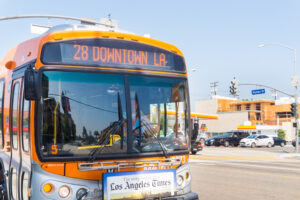
Addressing Long Commute Times along the Slauson Corridor
In 2018, the city of Los Angeles received a grant to develop a neighborhood-level climate resiliency plan for South Los Angeles. Working with community-based organizations
Variable Definitions:
Total Severe Vehicle Collisions: The number of vehicle collisions resulting in severe injury or death
Severe Collisions Involving Pedestrians: The number of vehicle & pedestrian collisions resulting in severe injury or death
Severe Collisions Involving Cyclists: The number of vehicle & cyclist collisions resulting in severe injury or death
All variables are presented as total counts and rates per 100,000 residents.
Source:
Statewide Integrated Traffic Records System (SWITRS)
Years Available:
2010 – 2022
Methodology Note:
The original data comes at the point level. Our team geocoded the locations to generate X/Y coordinates, then spatial joined each point to 2020 Census Tracts.
Traffic Collisions
Citation:
California Office of Traffic Safety. (2022). California Traffic Safety Quick Stats. CA OTS. Retrieved December 14, 2022, from https://www.ots.ca.gov/ots-and-traffic-safety/score-card/
Los Angeles Department of Transportation. (2016, March). Collision and Countermeasure: Literature Review.
Los Angeles Department of Transportation. (2017, January). 2017 Vision Zero Action Plan. Retrieved December 15, 2022, from https://ladotlivablestreets-cms.org/uploads/cb1ecdfacabb4bcd97c922382b165e79.pdf
Metropolitan Transportation Commission & Association of Bay Area Governments. (2017, January). Fatalities from Crashes. Vital Signs. Retrieved December 15, 2022, from https://www.vitalsigns.mtc.ca.gov/fatalities-crashes
Reynolds, S. J. (2021, March 30). Vision Zero Implementation Strategy – Calendar Year 2021.
Smith, D. (2022, January 9). Hundreds died in L.A. traffic crashes in 2021. Is Vision Zero a failure? L.A. Times.

In 2018, the city of Los Angeles received a grant to develop a neighborhood-level climate resiliency plan for South Los Angeles. Working with community-based organizations

Access to cost effective, time efficient and environmentally conscious transportation is a pressing issue affecting people around the world. In 2017, INRIX Global Traffic Scorecard

Across Los Angeles County’s vast and sprawling 4,751 square miles, more than 4.5 million commuters walk, bike, drive, rideshare or take public transit to get
